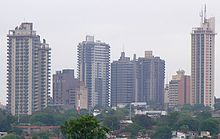Economy of Paraguay

|
|
| Currency | Paraguayan guaraní (PYG) |
|---|---|
| Calendar year | |
|
Trade organizations
|
WTO, Mercosur, Unasur |
| Statistics | |
| GDP |
|
|
GDP growth
|
|
|
GDP per capita
|
|
|
GDP by sector
|
agriculture: 19.9%; industry: 17.6%; services: 62.5% (2014 est.) |
|
|
|
|
Population below poverty line
|
34.7% (2010 est.) |
| 53.2 (2009) | |
|
Labor force
|
3.26 million (2014 est.) |
|
Labor force by occupation
|
agriculture: 26.5%; industry: 18.5%; services: 55% (2008) |
| Unemployment |
|
|
Main industries
|
sugar, cement, textiles, beverages, wood products, steel, base metals, electric power |
| 106th (2017) | |
| External | |
| Exports |
|
|
Export goods
|
soybeans, feed, cotton, meat, edible oils, electricity, wood, leather |
|
Main export partners
|
|
| Imports |
|
|
Import goods
|
road vehicles, consumer goods, tobacco, petroleum products, electrical machinery, tractors, chemicals, vehicle parts |
|
Main import partners
|
|
|
FDI stock
|
|
|
Gross external debt
|
|
| Public finances | |
|
|
|
| Revenues | $5.222 billion (2014 est.) |
| Expenses | $5.651 billion (2014 est.) |
|
Standard & Poor's: BB (Domestic) BB (Foreign) BB+ (T&C Assessment) Outlook: Positive Moody's: Ba2 Outlook: Stable |
|
|
Foreign reserves
|
|
Paraguay has a market economy highly dependent on agriculture products. In recent years, the economy has grown as a result of increased agricultural exports, especially soybeans. Paraguay has the economic advantages of a young population and vast hydroelectric power but has few mineral resources, and political instability has undercut some of the economic advantages present. The government welcomes foreign investment. Paraguay is a middle-income country that changed rapidly in the 1970s and 1980s as a result of hydroelectric development, agricultural colonization, construction, and cash crop exports. Nevertheless, the country's gross domestic product (GDP) in 1986 was approximately US$3.4 billion, or roughly US$1,000 per capita, ranking Paraguay only ahead of Bolivia among the Spanish-speaking countries of South America. Paraguay was the most agricultural economy of South America, and that sector influenced the performance of virtually every other sector of the economy. The over dependence on agricultural economy and low tax collections deteriorated the already wide gap wealth distribution. The extreme poverty increased from 16% to 20% during 2001 to 2012, even the economy growth. By 2013, it has a human development index of 0.669 which is even lower than Bolivia.
The Paraguayan economic miracle of the 1970s came to a halt in 1982 because of the completion of construction at Itaipú, lower commodity prices for cotton and soybeans, and world recession. The economy recovered in 1984 and 1985, stagnated in 1986, and continued to expand in 1987 and 1988. Despite its rapid growth, the Paraguayan economy became increasingly dependent on soybeans and cotton for exports and overall economic dynamism. These two crops, however, remained subject to external price fluctuations and local weather conditions, both of which varied considerably.
Economic growth in the post-World War II period occurred in the context of political stability characterized by authoritarian rule and patronage politics. Government economic policies deviated little from 1954 to the late 1980s, consistently favoring a strong private-enterprise economy with a large role for foreign investment. Unlike most Latin American economies, in Paraguay import tariffs were generally low, fiscal deficits manageable, and exchange rates not overvalued. These trends faltered in the 1980s as the government took a more active part in industry, deficits rose, and the national currency was generally overvalued and devalued numerous times. Throughout the post-World War II era, Paraguay had no personal income tax, and government revenues as a percentage of GDP were among the lowest in the world.
...
Wikipedia
